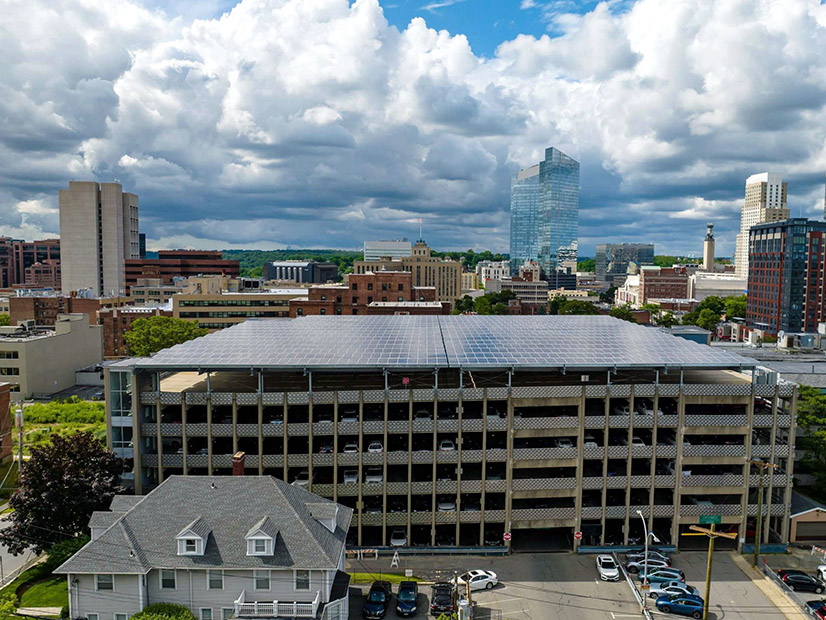
A trade group is calling for New York to double its goals for small-scale solar, which has enjoyed success as the state’s efforts to site large-scale renewable energy have faltered.
The New York Solar Energy Industries Association presented its road map to reach 20 GW of distributed solar on June 26, a day before its scheduled policy summit in New York City.
Small-scale solar has been a success story in New York state, which is on track to reach its 2025 goal of 6 GW distributed solar a year early. More than 2 GW of community solar generation capacity is installed, the most of any state in the nation.
By contrast, so many large-scale solar and wind projects have been delayed or canceled that some say the state’s goal of 70% renewable energy by 2030 is now unattainable. (See NY Won’t Meet Renewable Target, Industry Says at Summit.)
NYSEIA is calling for the current distributed solar goal — 10 GW by 2030 — to be changed to 20 GW by 2035.
Achieving “20X35” would entail only 7 to 10% annual growth in installation, NYSEIA said, much less than the 31% average annual growth seen in the past decade. The association noted that more than 800 MW of distributed solar capacity was installed in 2023 alone.
Small, distributed solar is well distributed across New York state and can be quite small: The national Solar Energy Industries Association dashboard puts New York’s total installed solar capacity at 5,834 MW in the first quarter of 2024 and indicates that 210,220 separate solar arrays have been installed to reach that total.
The NYSEIA road map draws a marked contrast between small-scale solar and New York’s large-scale renewables portfolio, which saw more than 11 GW of contract cancellations in the past year.
The authors write: “Conventional wisdom is that utility-scale solar can be deployed faster and cheaper than rooftop and community solar; however, New York has flipped that logic on its head: 93% of New York’s installed solar capacity is rooftop and community solar.”
Nationwide, the picture is different: The U.S. Energy Information Administration reports that small-scale photovoltaics (less than 1 MW nameplate capacity) accounted for only 31% of U.S. solar energy generation in 2023.
NYSEIA Executive Director Noah Ginsburg said in a news release: “As New York struggles to meet its ambitious renewable energy mandates, legislative leaders and regulators must take decisive action. Scaling up distributed solar deployment will deliver cost-effective progress toward New York’s overall climate goals while delivering immense benefits to New York’s environment, economy and working families.”
New York is pursuing a mix of large and small renewables as it works to make its clean energy vision a reality. This ranges from offshore wind farms each producing a gigawatt to rooftop solar arrays generating only a few kilowatts.
A Department of Public Services spokesperson said via email: “When it comes to the development of clean energy resources in New York, our focus will continue to be on both large-and small-scale generation. And that’s why we have initiatives in place — such as [Office of Renewable Energy Siting] for large-scale siting and our distributed energy resources network program for small scale projects — to quickly, efficiently and affordably develop clean energy projects.”
Home Rule Hinders Growth
While the road map draws a portrait of distributed solar as a success story in New York’s clean energy transition, it also explains some of the roadblocks the Empire State has put in the path of small-scale development.
Prominent among them is local opposition in a state with a strong home-rule tradition, which NYSEIA estimates is holding back up to 4.6 GW of distributed solar.
The Office of Renewable Energy Siting can usurp local authority, but only on projects with capacity of at least 20 MW.
This has an ironic effect, the road map asserts: “Many of these restrictive local laws are intended to stop utility-scale projects but only impact community-scale renewables.”
Much of the road map is a wish list of policy changes that NYSEIA says would be needed if a 20-GW-by-2035 goal is to be pursued.
“Business as usual is not an option. Achieving 20X35 will require policy intervention to address permitting, interconnection and economic barriers to distributed solar deployment,” the authors write.
Among the changes NYSEIA would like to see:
-
- state-level permitting support for community-scale clean-energy projects and state-provided financial benefits for host communities;
- permitting automation for residential projects, which can take a day or two to install but months to permit;
- improvements in the interconnection process — NYISO’s Standardized Interconnection Requirements is a good foundation, but timelines can be expedited, financial instruments can replace cash deposits for grid upgrades and cost certainty can be improved;
- use of flexible interconnection or smart grid technology to monitor and control DERs in real time instead of cost-prohibitive distribution system upgrades;
- proactive utility investments in the grid and cost-sharing reforms;
- electric tariff improvements taking into account the value of DERs;
- incentives for distributed solar-plus-storage serving as virtual power plants;
- modernization of the state’s residential solar tax credit;
- stretching the state’s distributed solar incentive program because it is ahead of schedule and under budget; and
- development of a 20 GW follow-up to the successful NY-Sun incentive program.



